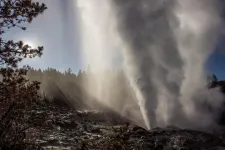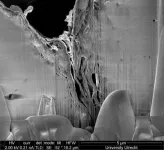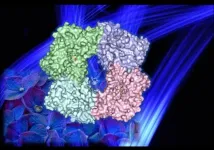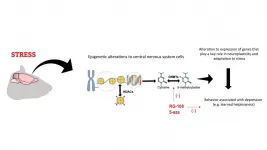(Press-News.org) When Yellowstone National Park's Steamboat Geyser -- which shoots water higher than any active geyser in the world -- reawakened in 2018 after three and a half years of dormancy, some speculated that it was a harbinger of possible explosive volcanic eruptions within the surrounding geyser basin. These so-called hydrothermal explosions can hurl mud, sand and rocks into the air and release hot steam, endangering lives; such an explosion on White Island in New Zealand in December 2019 killed 22 people.
A new study by geoscientists who study geysers throws cold water on that idea, finding few indications of underground magma movement that would be a prerequisite to an eruption. The geysers sit just outside the nation's largest and most dynamic volcanic caldera, but no major eruptions have occurred in the past 70,000 years.
"Hydrothermal explosions -- basically hot water exploding because it comes into contact with hot rock -- are one of the biggest hazards in Yellowstone," said Michael Manga, professor of earth and planetary sciences at the University of California, Berkeley, and the study's senior author. "The reason that they are problematic is that they are very hard to predict; it is not clear if there are any precursors that would allow you to provide warning."
He and his team found that, while the ground around the geyser rose and seismicity increased somewhat before the geyser reactivated and the area currently is radiating slightly more heat into the atmosphere, no other dormant geysers in the basin have restarted, and the temperature of the groundwater propelling Steamboat's eruptions has not increased. Also, no sequence of Steamboat eruptions other than the one that started in 2018 occurred after periods of high seismic activity.
"We don't find any evidence that there is a big eruption coming. I think that is an important takeaway," he said.
The study will be published this week in Proceedings of the National Academy of Sciences.
Manga, who has studied geysers around the world and created some in his own laboratory, set out with his colleagues to answer three main questions about Steamboat Geyser: Why did it reawaken? Why is its period so variable, ranging from 3 to 17 days? and Why does it spurt so high?
The team found answers to two of those questions. By comparing the column heights of 11 different geysers in the United States, Russia, Iceland and Chile with the estimated depth of the reservoir of water from which their eruptions come, they found that the deeper the reservoir, the higher the eruption jet. Steamboat Geyser, with a reservoir about 25 meters (82 feet) below ground, has the highest column -- up to 115 meters, or 377 feet -- while two geysers that Manga measured in Chile were among the lowest -- eruptions about a meter (3 feet) high from reservoirs 2 and 5 meters below ground.
"What you are really doing is you are filling a container, it reaches a critical point, you empty it and then you run out of fluid that can erupt until it refills again," he said. "The deeper you go, the higher the pressure. The higher the pressure, the higher the boiling temperature. And the hotter the water is, the more energy it has and the higher the geyser."
To explore the reasons for Steamboat Geyser's variability, the team assembled records related to 109 eruptions going back to its reactivation in 2018. The records included weather and stream flow data, seismometer and ground deformation readings, and observations by geyser enthusiasts. They also looked at previous active and dormant periods of Steamboat and nine other Yellowstone geysers, and ground surface thermal emission data from the Norris Geyser Basin.
They concluded that variations in rainfall and snow melt were probably responsible for part of the variable period, and possibly for the variable period of other geysers as well. In the spring and early summer, with melting snow and rain, the underground water pressure pushes more water into the underground reservoir, providing more hot water to erupt more frequently. During winter, with less water, lower groundwater pressure refills the reservoir more slowly, leading to longer periods between eruptions. Because the water pushed into the reservoir comes from places even deeper than the reservoir, the water is decades or centuries old before it erupts back to the surface, he said.
In October, Manga's team members demonstrated the extreme impact water shortages and drought can have on geysers. They showed that Yellowstone's iconic Old Faithful Geyser stopped erupting entirely for about 100 years in the 13th and 14th centuries, based on radiocarbon dating of mineralized lodgepole pine trees that grew around the geyser during its dormancy. Normally the water is too alkaline and the temperature too high for trees to grow near active geysers. The dormancy period coincided with a lengthy warm, dry spell across the Western U.S. called the Medieval Climate Anomaly, which may have caused the disappearance of several Native American civilizations in the West.
"Climate change is going to affect geysers in the future," Manga said.
Manga and his team were unable to determine why Steamboat Geyser started up again on March 15, 2018, after three years and 193 days of inactivity, though the geyser is known for being far more variable than Old Faithful, which usually goes off about every 90 minutes. They could find no definitive evidence that new magma rising below the geyser caused its reactivation.
The reactivation may have to do with changes in the internal plumbing, he said. Geysers seem to require three ingredients: heat, water and rocks made of silica -- silicon dioxide. Because the hot water in geysers continually dissolves and redeposits silica -- every time Steamboat Geyser erupts, it brings up about 200 kilograms, or 440 pounds of dissolved silica. Some of this silica is deposited underground and may change the plumbing system underneath the geyser. Such changes could temporarily halt or reactivate eruptions if the pipe gets rerouted, he said.
Manga has experimented with geysers in his lab to understand why they erupt periodically, and at least in the lab, it appears to be caused by loops or side chambers in the pipe that trap bubbles of steam that slowly dribble out, heating the water column above until all the water can boil from the top down, explosively erupting in a column of water and steam.
Studies of water eruptions from geysers could give insight into the eruptions of hot rock from volcanoes, he said.
"What we asked are very simple questions and it is a little bit embarrassing that we can't answer them, because it means there are fundamental processes on Earth that we don't quite understand," Manga said. "One of the reasons we argue we need to study geysers is that if we can't understand and explain how a geyser erupts, our hope for doing the same thing for magma is much lower."
INFORMATION:
The research, led by UC Berkeley graduate student and first author Mara Reed, resulted from a collaboration that started in one of the annual summer workshops put on by the Cooperative Institute for Dynamic Earth Research, or CIDER. Other co-authors are Carolina Munoz-Saez of the University of Chile and Rice University in Texas, Sahand Hajimirza of Rice University, Sin-Mei Wu of the University of Utah, Anna Barth of Columbia University in New York, Társilo Girona of the University of Alaska, Majid Rasht-Behesht of Brown University in Rhode Island, Erin White of Yellowstone National Park in Wyoming, Marianne Karplus of the University of Texas and Shaul Hurwitz of the U.S. Geological Survey in California.
UNIVERSITY PARK, Pa. -- American politicians have long been expected to uphold a certain veneer: powerful, influential and never vulnerable. New Penn State research has found that these idealized forms of masculinity may also help explain support for Donald Trump in the 2016 presidential election and in the days leading up to the 2020 election.
Across several studies, the researchers found that when men and women endorsed "hegemonic masculinity" -- a culturally idealized form of masculinity that says men should be strong, tough, and dominant -- they were more likely to vote for and have positive feelings about Trump.
The researchers found this was true ...
A geosciences team led by the University of South Florida (USF) has developed a new way to reconstruct the sizes of volcanic eruptions that occurred thousands of years ago, creating a first-of-its kind tool that can aid scientists in understanding past explosive eruptions that shaped the earth and improve the way of estimating hazards of future eruptions.
The advanced numerical model the USF team developed allows scientists to reconstruct eruption rates through time by estimating the dimensions of the umbrella clouds that contribute to the accumulation ...
CHICAGO --- While many physicians benefit from social media by networking with potential collaborators or interfacing with patients, a new study from Northwestern University and the University of Chicago found many physicians also report being sexually harassed and personally attacked on these platforms on the basis of their religion, race or medical recommendations.
Although the data were collected before the COVID-19 outbreak, the findings highlight the intensity of online harassment before the pandemic, which has only intensified since the spring, the study authors said.
"If anything, our data is likely an underestimate of the true ...
LOS ANGELES -- A growing number of women forgoing reconstruction after a mastectomy say they're satisfied with their choice, even as some did not feel supported by their physician, according to a study led by researchers at the UCLA Jonsson Comprehensive Cancer Center.
The study, published in the Journal Annals of Surgical Oncology, surveyed 931 women who had a unilateral or bilateral mastectomy without current breast mound reconstruction to assess the motivating factors for forgoing the procedure and to measure whether surgeons provided adequate information and support for "going flat."
Out of the women surveyed, 74% were satisfied with their outcome and 22% experienced "flat denial," where the procedure was not initially offered, the ...
Of the 5,300 children enrolled in the Ohio Behavioral Health Juvenile Justice Initiative since 2006, 21% reported that someone close them had been murdered in the past year. Nearly half of the boys and more than a quarter of the girls in the program have both a substance abuse and mental health disorder.
But there's good news, too: From 2017 through 2019, 81% of the participants--aged 10 through 17--successfully completed the state's juvenile diversion program, and data indicated that 79% of youth reduced their contact with police while in treatment.
Those findings are from a new detailed evaluation of the Ohio Behavioral Health Juvenile Justice Initiative (BHJJ) by researchers at the Jack, Joseph and ...
Boulder, Colo., USA: Europe's largest gas field, the Groningen field in the Netherlands, is widely known for induced subsidence and seismicity caused by gas pressure depletion and associated compaction of the sandstone reservoir. Whether compaction is elastic or partly inelastic, as implied by recent experiments, is key to forecasting system behavior and seismic hazard.
Bart Verberne and colleagues sought evidence for a role of inelastic deformation through comparative microstructural analysis of unique drill-core, recovered from the seismogenic center of the field in 2015, 50 years after gas production started, versus core recovered before production (1965). Quartz grain fracturing, crack healing, and stress-induced Dauphiné twinning are ...
BOSTON - A long-running debate over how an important gene-silencing protein identifies its targets has been resolved by researchers at Massachusetts General Hospital (MGH). Their findings, reported in Nature Structural and Molecular Biology, also explain certain mysteries about the behavior of this protein, known as Polycomb repressive complex 2 (PRC2).
PRC2 helps regulate whether genes are active ("on) or silent ("off"). PRC2's role in gene silencing is critical throughout the lifespan, from embryo formation to old age. For example, PRC2 determines whether genes that suppress the growth of malignant tumors are turned on or off, which has made it the focus of pharmaceutical companies ...
If you've ever had a bad case of jet lag, you know how a disruption to your body's circadian rhythm makes it difficult to function. Molecular circadian "clocks" exist in cells throughout the body, governing more than just sleep and wake cycles - they are crucial to many aspects of human health. For more than a decade researchers have been trying to figure out what makes them tick, in search of new insights into diseases like Alzheimer's, cancer and diabetes.
Until now, that research has focused on what is known as clock genes, which encode proteins that drive oscillating cycles of gene expression affecting physiology and behavior. But research just published in the Proceedings of the National Academy of Sciences reveals the discovery ...
Plants can perceive and react to light across a wide spectrum. New research from Prof. Nitzan Shabek's laboratory in the Department of Plant Biology, College of Biological Sciences shows how plants can respond to blue light in particular.
"Plants can see much better than we can," Shabek said.
Plants don't have dedicated light-detecting organs, like our eyes. They do have a variety of dedicated receptors that can sense almost every single wavelength. One such are the blue light photoreceptors called cryptochromes. When the cryptochrome detects an incoming photon, it reacts in a way that triggers a unique physiological response.
Cryptochromes probably appeared billions of years ago with the first living ...
By Karina Ninni | Agência FAPESP – Treatment of depression faces two main challenges. The first is that almost 50% of patients do not respond well to existing antidepressants. The second is that conventional medications take a relatively long time – around three to five weeks – to have the desired effect. A group of researchers affiliated with the University of São Paulo (USP) in Brazil set out to tackle the second problem by using epigenetic modulators to try to “erase” the consequences of stress. Epigenetic mechanisms are part of a complex system that controls how and when genes are switched on or off.
Exposure to stress, a key trigger of depression, alters certain epigenetic markers in the brain. Many of these alterations ...




